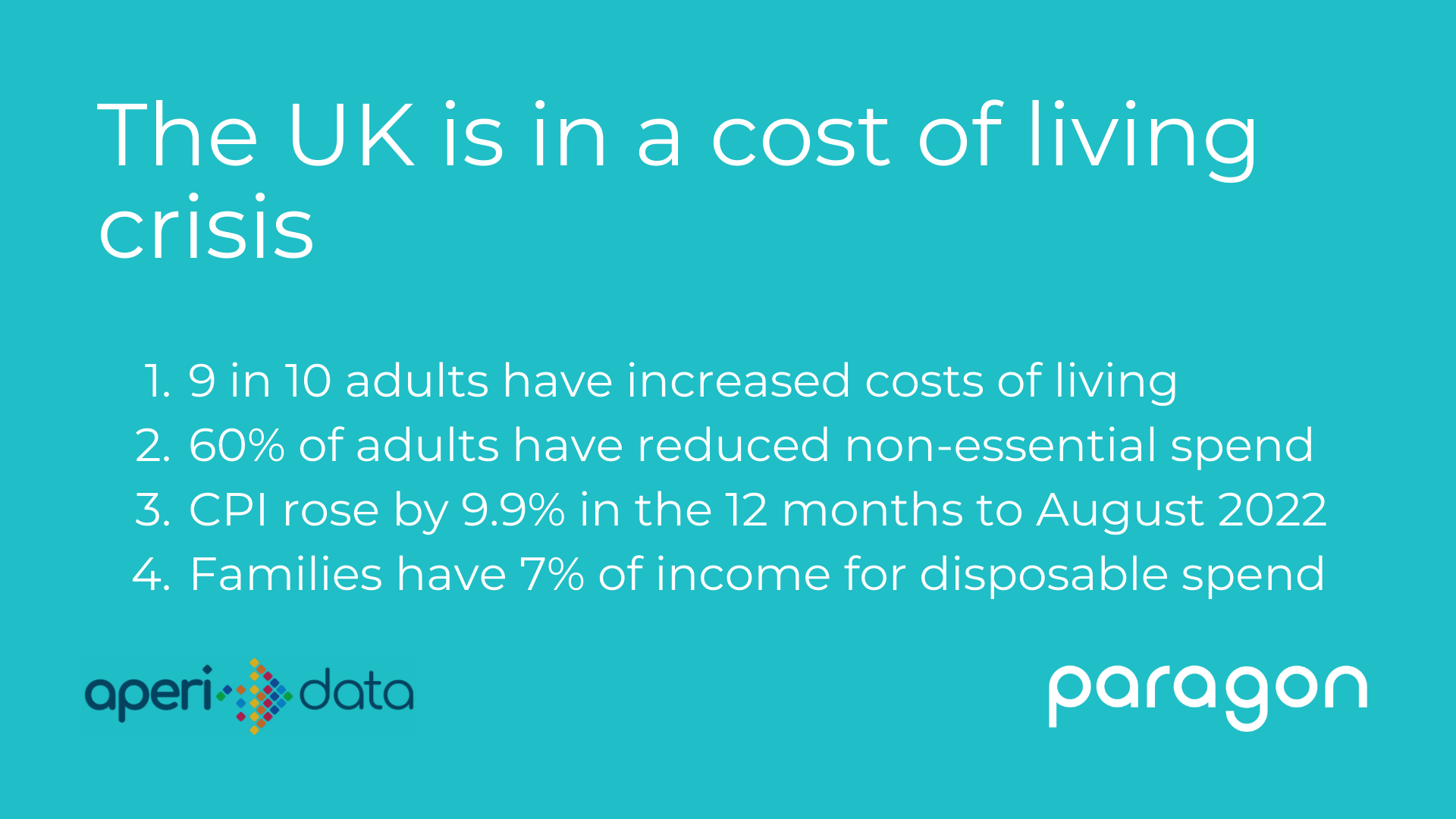The UK is in a Cost of Living Crisis - how Open Banking can help
This article has been written in collaboration with Aperidata, transforming credit scoring through the power of open data.
Many factors are contributing to a real cost of living crisis felt across the UK. Around 9 in 10 adults report that their costs of living have increased, equivalent to over 45 million people, and a reported 60% of adults are spending less on non-essential items.
The Consumer Prices Index (CPI) rose by 9.9% in the 12 months to August 2022. This has driven the average cost of living for UK households to £3,037 per month and for single people to £2,005 per month. This has resulted in families being left with only 7% of their income available for disposable spending. The average single key worker has been significantly impacted where there is typically a debt of £48 after all essential costs are taken into consideration.
Housing costs in particular are continuing to rise. The Consumer Prices Index including owner occupier housing costs (CPIH) rose by 8.6% in the 12 months to August 2022. Rental costs have increased to an average of £755 per month, with London costs being around double the UK average.
This is having an impact on individuals across all demographics, which has knock on effects to the financial services sector. For new lending, it is imperative that not only is affordability established but also that this affordability is stress-tested to ensure products remain affordable through their duration. The FCA mandate that affordability is assessed and evidenced (Chapter 5 CONC), and organisations must be prepared to act in this area.
To address this, organisations should seek to leverage the best information available to assess customers, both in new lending and ongoing customer treatment activities including collections. Traditionally models are developed using statistical averages. These models, while still valid when taking a portfolio level view, do not necessarily meet the needs on the ground at individual customer level. Open Banking data can enable specific decision making at customer level rather than relying on grouped averages and enables model enrichment as models are continually assessed for validity.
How Open Banking can help
Open Banking data is a powerful lens into a customer's financial health. It can show, for example:
If and by how much different spend categories have increased (e.g., utilities, mortgage payments, rent payments, other loan payments)
When new loans have been opened
When monthly income has changed
How much ‘wiggle room’ do customers currently have, and how will this change if certain spend types increase further?
It is interesting to note that Open Banking data has even greater value than in pre Covid times because of Covid spend behaviours. Greater proportions of expenditure are now made through card payments as opposed to cash which enables more comprehensive spending categorisation. By using this very granular income and expenditure data, organisations can better highlight choices and options the customer may not be aware of. For example, could they be spending less in certain areas? Or could their debts be restructured, thus reducing their monthly outgoings?
The insights and understanding that this data provides can help lenders find the best option or deal for their customers at a level that aligns with their policies and risk appetite. Knowing more about a customer’s or household’s situation and affordability ensures more and better informed decisions can be made. And not only does this data broaden the understanding of the customer, it is a near real-time view of transactions available to the present day. With this data being up to date and never stale, there is incremental value and insight over and above other powerful sources such as credit reference agency data.
Lenders that automate the use of this data will be at a distinct advantage, benefitting both them and their customers. Decision engines play an important role in this automation, to easily integrate with existing data sources and adopt new data fields, models, and calculations for better, more informed and more efficient decisions. Paragon has enhanced the decision engine concept with a specialist Open Banking decision module, providing the capability for the effective ongoing management of the (open) data-driven decisions, allowing quick and agile changes and updates to lending decisions. For example, if there are changes in a lenders risk appetite or consumers’ costs of living, customer strategies and decisions can be quickly and easily changed with greater control and governance. These changes are all recorded providing a complete history and audit trail of lending policy and decision strategy, with the data from every decision processed being automatically captured and stored for future analysis, learning and modelling.
To learn more about the power of integrating Aperidata’s enriched Open Banking data with Paragon’s flexible Open Banking Decision Module please get in touch.
Further Reading
Cost Of Living
Affordability


